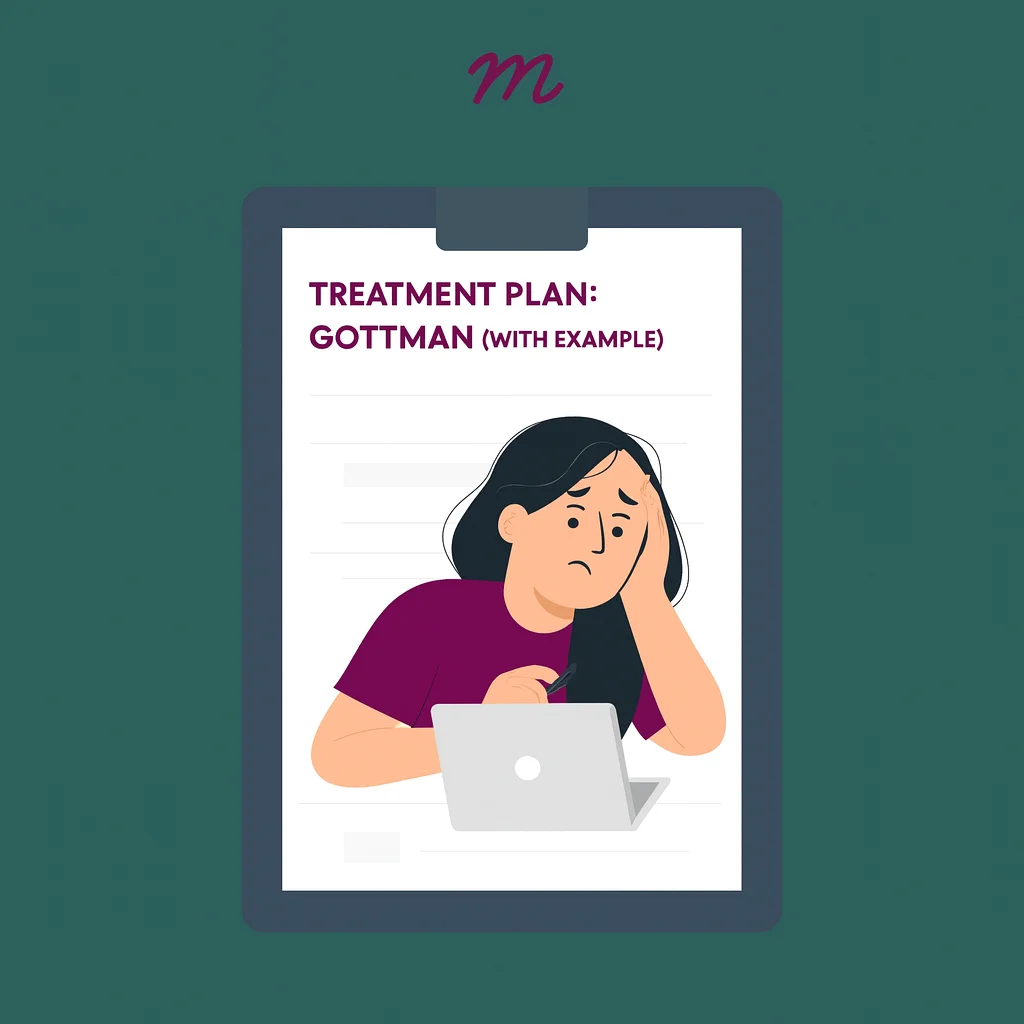As mental health practitioners, we often come across couple clients dealing with communication issues, emotional disconnection, and unresolved conflicts. Dr. John Gottman’s research-driven method provides a systematic framework that can lead couples to deeper intimacy and lasting fulfilment. The Gottman treatment plan method developed by Dr. John Gottman and Dr. Julie Schwartz Gottman over 40 years, has its roots in scientific studies and includes nine key parts that form the “Sound Relationship House Theory.”
The Sound Relationship House Theory

- Building a Foundation of Friendship – This is the first element of the House. Couples are encouraged to develop a deep, emotional connection by being each other’s best friend – through shared activities, interests, and consistent communication.
- Enhancing Fondness and Admiration, the focus is on strengthening the relationship by nurturing feelings of fondness and admiration between the partners. Couples learn to focus on the positive aspects of their partner, emphasizing what they love and appreciate about them.
- Turning Toward Each Other, the third element focuses on turning toward each other in moments of need. Couples learn how to respond to each other’s bids for attention, affection, and support. By consistently turning toward each other instead of away, couples create a sense of security and mutual respect.
- As we climb the relationship house, we encounter the fourth component, The Positive Perspective – this allows couples to keep an optimistic outlook even during disagreements, tackling obstacles together instead of as rivals.
- The fifth component, Managing Conflict, shows couples how to deal with both short-term and ongoing (long term) issues. They learn gentle ways to start conversations, accept each other’s input, and find middle ground.
- The sixth component Making Life Dreams Come True, pushes partners to back each other’s goals while setting shared targets. This builds a feeling of growing together.
- The seventh element Creating Shared Meaning, aids couples in building their own culture of shared values, rituals, and traditions. This deepens their bond beyond daily routines.
- The eighth element Trust, acts as a key wall of the relationship house. It stresses being reliable, dependable, and safe with each other.
- The ninth element, Commitment, completes the house. It centers on staying loyal, dedicated, and seeing the relationship as a long-term investment worth caring for and guarding.
As a practitioner you can use the following questions to reflect on your sessions with couple clients-
- Which of these pillars does your client often struggle with?
- How can you help clients recognize and strengthen their foundation of friendship?
- What strategies can you use to guide couples in managing conflict more constructively?
A unique aspect of Gottman therapy is its focus on identifying and acknowledging “The Four Horsemen” of relationship apocalypse: criticism, contempt, defensiveness, and stonewalling. These communication patterns have been shown to be particularly destructive to a relationship’s well- being.
Who is Gottman Therapy for?
Couples seeking Gottman therapy come from diverse backgrounds and might be at different stages in their relationships. Some may be in a state of crisis, perhaps after discovering infidelity or seriously considering divorce. Others might be dealing with ongoing issues that have led to emotional distance over time. There are also those who proactively seek assistance to enhance an already healthy relationship or to prepare for significant life changes such as marriage or parenthood.
Components of a Gottman Treatment Plan
A comprehensive Gottman treatment plan incorporates five key characteristics:
- Specificity: Identifies concrete areas of what are relationship’s strengths and what are the pain points
- Measurability: The method utilizes research-based tools for tracking the progress
- Attainability: Sets realistic and achievable goals
- Relevance: Aligns with the couple’s therapeutic goals
- Time-bound: Provides a clear timeline for achieving the set goals
The Treatment Planning Process
Gottman therapy begins with an assessment phase which spans over three to four sessions. The assessment phase has the following components –
- Joint and individual interviews – Understanding both partners’ perspectives and relationship dynamics.
- Filling questionnaires – Assessing relationship strengths, challenges, and areas of concerns.
- Conflict discussion observation – Analysing real time interactions of the partners to identify patterns in communication and conflict resolution.
Through this comprehensive assessment, the therapist attempts to map the couple’s difficulties onto the Sound Relationship House framework, identifying specific areas for improvement.
Intervention Strategies
The core interventions in a Gottman therapy modality focus on:
- De-escalating the conflict – Learning to identify and manage negative interactions before they intensify and escalate.
- Expressing needs effectively – Swapping criticism and defensiveness with clear, and healthy communication.
- Rebuilding trust – Implementing exercises to repair unproductive communication and patterns and to enhance emotional security in the relationship
- Strengthening friendship – Enhancing emotional connection through daily positive interactions. For example – texting each other to check in once in the day, watching a stand up and laughing together, etc.
- Creating shared goals – Aligning values and aspirations to foster unity and partnership. For example – setting a goal to run a 5K together.
- Managing perpetual problems – Developing strategies to navigate ongoing disagreements with mutual understanding. For example, if one partner is messy while the other one respects keeping things organised, instead of always arguing in circles they can find a middle ground. They can set up a compromise like designating certain spaces as “your mess” vs. “My clean space.”
- Developing rituals of connection – Establishing meaningful traditions that reinforce intimacy and commitment. For example, cooking together on Fridays or keeping phones away during meals.
Case Study
Context
Priya and Anjali are a same sex couple from India. They have been seeking therapy due to increasing problems in their relationship. They both share a strong emotional bond, however their struggles lie with family acceptance, healthy communication, and have conflicting expectations about their future that have created a rift. Priya, who was open about her sexuality with her friends, feels frustrated by Anjali’s hesitation to be fully out to her conservative family and friends. Meanwhile, Anjali feared rejection and struggled with anxiety over societal judgment regarding her relationship so she kept it a secret.
Assessment Phase
The therapist conducted individual sessions with each partner to assess their personality, communication style, expectations, relationship history, emotional needs, and sources of conflict.
The couple was asked to complete a Gottman Relationship Checkup. It was found out that while they had a solid friendship base, their conflict resolution patterns were destructive, often they both resorted to stonewalling and defensiveness during their conflicts which led to unproductive communication.
Building a Strong Foundation
Intervention – Love Maps Exercise
- An exercise where both the partners have to answer questions about each other’s inner world, daily life, dreams and aspirations. The goal of the activity is to help deepen the emotional connection and prevent partners from drifting apart.
- Priya and Anjali participated in guided conversations to rediscover each other’s hopes, dreams, and stressors.
- This helped Anjali express her fears of societal and familial rejection, while Priya gained a deeper understanding of the emotional intensity and anxiety Anjali carried.
Intervention – Expressing Fondness and Admiration
- An activity where the partners practice intentional appreciation by expressing what they love about their partner, reducing negativity and resentment towards each other.
- The couple was encouraged to verbalize appreciation in their everyday life, reducing resentment and increasing positive interactions.
Outcome – Within a few weeks, Anjali and Priya reported feeling closeness. Priya worked on showing greater patience and Anjali initiated more affection based dialogue.
Managing Conflict Effectively
| Interventions | |
|---|---|
| The Four Horsemen | Antidotes |
| Criticism | Use Gentle Start-Up |
| Contempt | Express Appreciation |
| Defensiveness | Take Responsibility |
| Stonewalling | Self-Soothe |
- Priya and Anjali identified criticism and stonewalling as their primary destructive patterns.
- The therapist helped them in replacing criticism with gentle start-ups – Instead of blaming, using “I” statements and expressing needs kindly
- For example, using “I feel hurt when…” instead of “You never listen”.
Intervention – Compromise Ovals
- This activity is about writing down their non-negotiables and flexible areas in any kind of disagreement. The goal is to be able to find a middle ground.
- For Priya and Anjali, this could be –
Non-Negotiables: Priya might write down things like – “Respect for personal space” or feeling heard. Anjali might have things like – “Honesty in communication” or “Respecting her boundaries”
Flexible Areas: They both might be flexible on things like – “Where they go for hangouts” or “What time they both meet.”
Intervention – Dreams Within Conflict Exercise
- This technique is about discovering deeper emotional needs behind conflicts. For example, a partner might be needing more independence because of past trauma.
- Anjali expressed that her reluctance to come out has its roots in fear of letting down her family. Priya gained the insight that her frustration was driven by a need for security and validation in their relationship.
- By recognising these underlying dreams, they both developed a middle ground where Anjali would take gradual steps toward coming out to her close family members and friends, and Priya would support her without pressuring urgent disclosure.
Outcome – Conflict discussions became less destructive and volatile and they felt more emotionally connected with each other.
Strengthening Trust and Commitment
Intervention – Rituals of Connection
- Rituals of connection could include – creating daily, or weekly habits that strengthen the relationship. Such as morning hugs or weekly movie nights.
- Priya and Anjali, journaled together to create a weekly “safe space” check-ins to be able to discuss emotions and stressors.
- They also started a tradition of attending LGBTQ+ community events and pride marches together to reinforce their shared identity.
Intervention – Trust-Building Exercises
- These are small activities that help in building trust between the couple. An example could be – following through on promises, and showing up emotionally during times of crisis.
- The therapist guided Priya and Anjali through these activities reinforcing reliability and emotional safety, such as writing down commitments to each other and reflecting on past moments of trust.
Outcome – Anjali felt more secure in taking steps towards being open about her identity and her relationship, while Priya developed patience and reassurance in their long-term commitment of being together.
Skill Integration & Maintenance
Intervention – State of the Union Meetings
- These meetings are – a discussion where couples come together on a weekly basis to openly discuss what’s working, what’s challenging, and how to improve things that are not working.
- Priya and Anjali held weekly reflections on what was working and areas needing improvement. They learned to navigate stress without turning on each other by working with each other.
Outcome – About seven months later, Priya and Anjali reported improvements in their communication, emotional safety, and shared aspirations for the future. Anjali became comfortable sharing their relationship with a select few close family members, and Priya learned to provide support without creating a sense of urgency.
Conclusion
A well structured Gottman treatment plan provides therapists as well as couples with a clear roadmap to building a healthy relationship. Gottman’s therapy can facilitate couples to move from conflict to connection by implementing systematic assessments, targeted interventions, and regular progress tracking.
Why other mental health professionals love Mentalyc

“For those who have hesitations … It is a lifesaver. It will change your life and you have more time to be present with your patients.”
Licensed Clinical Social Worker

“It immediately changed my quality of life, personally and professionally. I went from 3–4 hours a week of notes to 1 hour at most … that alone is invaluable personally and professionally.”
Owner/Independently Licensed Marriage & Family Therapist (IMFT)

“Do yourself a favor, make your life easier. Use the tools that are readily available … I found Mentalyc to be one of the best tools that I’ve ever used.”
Licensed Marriage and Family Therapist

“If I were recommending this software to a colleague, I would tell them that it is the best thing that they could do for their practice.”
Licensed Professional Counselor







